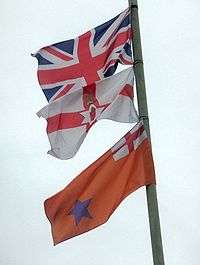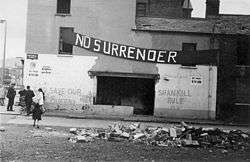Ulster loyalism
Ulster loyalism is the political movement for maintaining Northern Ireland within the United Kingdom. Like most unionists, loyalists are attached to the British monarchy, support the continued existence of Northern Ireland, and oppose a united Ireland. Ulster loyalism is a form of British patriotism.[1][2]

Ulster loyalism emerged in the late 19th century, as a response to the Irish Home Rule movement, and the rise of Catholic Irish nationalism. Although most of Ireland was Catholic, in the province of Ulster, Protestants were a near-majority. Ulster was also more industrialized than other parts of Ireland and was heavily dependent on trade with Great Britain. Loyalism began as a self-determination movement among Ulster Protestants who did not want to become part of an autonomous Ireland. While some Irish Catholics were also unionist, loyalism emphasized a Protestant and British heritage. These movements led to the partition of Ireland in 1921; most of Ireland became an independent state, while about two-thirds of Ulster remained within the United Kingdom as a self-governing territory called Northern Ireland.
Since partition, most loyalists have supported upholding Northern Ireland's status as a part of the United Kingdom, i.e. unionism. The terms 'unionist' and 'loyalist' are often used interchangeably. Loyalists are also described as being loyal primarily to the Protestant British monarchy rather than to the British government and institutions.[3] Garret FitzGerald argued that loyalists are loyal primarily to 'Ulster' rather than to 'the Union'.[4] A small minority of loyalists have called for an independent Ulster Protestant state, believing that they cannot rely on the British government to support their cause (see Ulster nationalism).
In Northern Ireland there is a tradition of loyalist Protestant marching bands. There are hundreds of such bands who hold numerous parades each year. The yearly Eleventh Night (11 July) bonfires and The Twelfth (12 July) parades are associated with loyalism.
Background
The term loyalist was first used in Irish politics in the 1790s to refer to Protestants who opposed Catholic Emancipation and Irish independence from Great Britain.[5]
Upon the partition of Ireland in 1921, six of the nine counties in the province of Ulster did not join the newly independent Irish Free State (later the Republic of Ireland) and remained a part of the United Kingdom. Academically cited records from 1926 indicate that at that stage 33.5% of the Northern Ireland population was Roman Catholic, with 62.2% belonging to the three major Protestant denominations (Presbyterian 31.3%, Church of Ireland 27%, Methodist 3.9%).[6]
Tensions between Northern Ireland's Catholic population (which mostly supported a united Ireland) and its Protestant population (which mostly supported remaining part of the UK) led to a long-running bloody insurgency known as the Troubles from the late 1960s to the late 1990s.
Political parties

- Active parties
- Democratic Unionist Party (DUP)
- Ulster Unionist Party (UUP)
- Traditional Unionist Voice (TUV)
- Progressive Unionist Party (PUP), which is linked to the Ulster Volunteer Force (UVF) and Red Hand Commando (RHC)
- Former parties
- Protestant Coalition (2013-2015)
- Ulster Democratic Party (1981–2001)
- Ulster Vanguard (1972–1978)
- Volunteer Political Party (1974)
- Ulster Protestant League (1930s)
Paramilitary and vigilante groups
Loyalist paramilitary and vigilante groups have been active since the early 20th century. In 1912, the Ulster Volunteers were formed to stop the British Government granting self-rule to Ireland, or to exclude Ulster from it. This led to the Home Rule Crisis, which was defused by the onset of World War I. Loyalist paramilitaries were again active in Ulster during the Irish War of Independence (1919–22),[7] and more prominently during the Troubles (late 1960s–1998). The biggest and most active paramilitary groups existed during the Troubles, and were the Ulster Volunteer Force (UVF), and the Ulster Defence Association (UDA)/Ulster Freedom Fighters (UFF). They, and most other loyalist paramilitaries, are classified as terrorist organizations.
During the Troubles, their stated goals were to combat Irish republicanism – particularly the Provisional Irish Republican Army (IRA) – and to defend Protestant loyalist areas.[8][9] However, the vast majority of their victims were Irish Catholic civilians, who were often killed at random in sectarian attacks.[10][8] Whenever they claimed responsibility for attacks, loyalists usually claimed that those targeted were IRA members or were helping the IRA.[11] M. L. R. Smith wrote that "From the outset, the loyalist paramilitaries tended to regard all Catholics as potential rebels".[12] Other times, attacks on Catholic civilians were claimed as "retaliation" for IRA actions, since the IRA drew most of its support from the Catholic community.[8][10][13] Such retaliation was seen as both collective punishment and an attempt to weaken the IRA's support; some loyalists argued that terrorizing the Catholic community and inflicting a high death toll on it would eventually force the IRA to end its campaign.[12][14]
Loyalist paramilitaries were responsible for about 30% of all deaths in the Troubles,[15] and were responsible for about 48% of all civilian deaths.[16] Loyalist paramilitaries killed civilians at far higher rates than both Republican paramilitaries and British security forces.[17]
The modus operandi of loyalist paramilitaries involved assassinations, mass shootings, bombings and kidnappings. They used sub machine-guns, assault rifles, pistols, grenades (including homemade grenades), incendiary bombs, booby trap bombs and car bombs. Bomb attacks were usually made without warning. However, gun attacks were more common than bombings.[14] In January 1994, the UDA drew up a 'doomsday plan', to be implemented should the British Army withdraw from Northern Ireland. It called for ethnic cleansing and re-partition, with the goal of making Northern Ireland wholly Protestant.[18]
Some loyalist paramilitaries have had links with far-right and Neo-Nazi groups in Britain, including Combat 18,[19][20] the British National Socialist Movement,[21] and the National Front.[22] Since the 1990s, loyalist paramilitaries have been responsible for numerous racist attacks in loyalist areas.[23] A 2006 report revealed that 90% of racist attacks in the previous two years occured in mainly loyalist areas.[24]
In the 1990s, the main loyalist paramilitaries called ceasefires. Following this, small breakaway groups continued to wage violent campaigns for a number of years, and members of loyalist groups have continued to engage in sporadic violence.
Fraternities and marching bands
In Northern Ireland there are a number of Protestant fraternities and marching bands who hold yearly parades. They include the Orange Order and Apprentice Boys of Derry. These fraternities, often described as the "Loyal Orders",[25] have long been associated with unionism/loyalism.[26] Yearly events such as the Eleventh Night (11 July) bonfires[27] and The Twelfth (12 July) parades are strongly associated with loyalism. A report published in 2013 estimated there were at least 640 marching bands in Northern Ireland with a total membership of around 30,000, an all-time high.[28] According to the Parades Commission, a total of 1,354 loyalist parades (not counting funerals) were held in Northern Ireland in 2007.[29] The Police Service of Northern Ireland uses different statistics, and recorded a total of 2,863 parades in 2007. Of these, 2,270 (approximately 80%) were held by loyalist marching bands.[30]
Other groups
Bibliography
- Potter, John Furniss. A Testimony to Courage – the Regimental History of the Ulster Defence Regiment 1969 – 1992, Pen & Sword Books Ltd, 2001, ISBN 0-85052-819-4
- Ryder, Chris. The Ulster Defence Regiment: An Instrument of Peace?, 1991 ISBN 0-413-64800-1
References
- Ignatieff, Michael. Blood and Belonging: Journeys into the New Nationalism. Vintage, 1994. p.184.
- John McGarry and Brendan O'Leary. Explaining Northern Ireland. Wiley, 1995. pp.92–93.
- Alison, Miranda. Women and Political Violence. Routledge, 2009. p.67.
- Cochrane, Fergal. Unionist Politics and the Politics of Unionism since the Anglo-Irish Agreement. Cork University Press, 2001. p.39.
- Arthur Lyon Cross (1920). A shorter history of England and greater Britain. The Macmillan company. pp. 593–595, 597. Retrieved 18 November 2011.
- "Background Information on Northern Ireland Society – Religion". Conflict Archive on the Internet. Retrieved 21 August 2016.
- "Irish War of Independence". The Irish War. 24 May 2010. Retrieved 1 December 2016.
- Doherty, Barry. Northern Ireland since c.1960. Heinemann, 2001. p15
- "A history of the UDA". BBC News. 6 January 2010. Retrieved 28 March 2010.
- McKittrick, David (12 March 2009). "Will loyalists seek bloody revenge?". The Independent. Retrieved 21 June 2011.
- Kentucky New Era, 14 April 1992
- Smith, M L R. Fighting for Ireland?. Psychology Press, 1997. p.118
- Tonge, Jonathan. Northern Ireland. Polity, 2006. p.157
- Mitchell, Thomas G (2000). "Chapter 7 subsection: The Loyalist terrorists of Ulster, 1969–94". Native vs. Settler. Greenwood Press. pp. 154–165.
- "Sutton Index of Deaths: Summary of Organisation responsible". Conflict Archive on the Internet (CAIN). Retrieved 1 March 2016.
- "Sutton Index of Deaths: Crosstabulations (two-way tables)". Conflict Archive on the Internet (CAIN). Retrieved 1 March 2016. (choose "organization summary" and "status summary" as the variables)
- "Statistics of Deaths in the Troubles in Ireland". www.wesleyjohnston.com.
- Wood, Ian S. Crimes of Loyalty: A History of the UDA. Edinburgh University Press, 2006. pp.184–185.
- Goodrick-Clarke, Nicholas. Black Sun: Aryan Cults, Esoteric Nazism, and the Politics of Identity. NYU Press, 2003. p.45.
- McDonald, Henry (2 July 2000). "English fascists to join loyalists at Drumcree". London: The Observer. Retrieved 30 December 2010.
- Goodrick-Clarke, pp.40–41.
- Wood, Ian S.Crimes of Loyalty: A History of the UDA. Edinburgh University Press, 2006. pp.339–40.
- "Racist war of the loyalist street gangs". The Guardian, 10 January 2004. Retrieved 21 October 2012.
- "Loyalists linked to 90 per cent of race crime". The Guardian. 22 October 2006.
- Glossary of terms on the Northern Ireland conflict. Conflict Archive on the Internet (CAIN)
- Tonge, Johnathan. Northern Ireland. Polity, 2006. pages 24, 171, 172, 173.
- Simpson, Mark (10 July 2009). "Turning hotspot into friendly fire". BBC News. Retrieved 13 July 2009.
- "Loyalist band numbers at new high" The Newsletter
- All information in this section from the Parades Commission website.
- "Police Service of Northern Ireland". www.psni.police.uk.